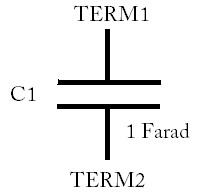The Capacitor:
What is it?
A capacitor is one of the most useful electrical components used to do economic and financial analysis.
A capacitor is a little like a car battery, since a capacitor stores electrical charge. Like a
battery, a capacitor also has two terminals. Unlike a battery that is limited to a particular voltage, a capacitor
can have any voltage. This makes the capacitor very powerful.
What is it good for?
The charge stored on a capacitor can represent an economic commodity such as wealth, debt, gold extracted
from a mine or the number of toasters produced by a factory. Any economic entity that can be imagined can
also be modeled using a capacitor.

Tell me more!
At the left is shown the electrical symbol for a capacitor. The capacitor
at the left is named C1 and is connected between TERM1 and TERM2. The charge storing capability of a
capacitor is given a value that is referred to as capacitance. The capacitance value of this particular
capacitor is one farad.
A simple equation relates the capacitance value, C, to the voltage across the capacitor terminals, V, to
the amount of charge, Q, that is stored in the capacitor. This simple equation is:
Q=CV (charge is equal to capacitance times voltage)
If we put a voltmeter across this particular capacitor and measure one volt, we could then use this equation
to find the charge stored in the capacitor. In this case the charge, Q, would be one coulomb. If we
measured 12 volts, then the charge would be 12 coulombs. Most of the capacitors used in our simulations
will have a value of 1 farad so that the relation of voltage across the capacitor, V, to stored
charge, Q, will be one to one.
But how do we use a capacitor to do economic and financial simulations? We simply use the value of the
charge in the capacitor to represent an economic value. For example, a charge of one coulomb stored in
the capacitor could represent one thousand dollars stored in a savings account. In this particular
capacitor with a value of one farad, all we need to do is measure the voltage across the capacitor to
know how much we have in our savings account. If we measure one volt, then we have one thousand dollars.
If we measure two volts, then we have two thousand dollars etc..
But how do we add charge to a capacitor and remove charge from a capacitor? This is done by using another
electrical component called a Voltage Controlled Current Source. The function of this electrical component
will be explained in the next section.
SPICE Description Format for the Capacitor:
A text editor can be used to make a SPICE input file that describes the circuit model used to do an economic simulation.
The SPICE program will read this circuit description file and then simulate the behavior of the circuit model. The
SPICE format used to describe the capacitor pictured at the top left of this page is shown below:
C1 TERM1 TERM2 1
The first character in this description must be a "C" so that the SPICE program knows that this circuit element is a
capacitor. C1 is the name of this particular capacitor. All element names in the SPICE circuit description must be
unique. The name used for a second capacitor element in our circuit description could be C2 or C_debt etc..
The TERM1 and TERM2 in the capacitor circuit description are the names of the capacitor terminal
connections (also called circuit nodes). Some capacitors have a polarity.
In this case the TERM1 is the positive terminal of the capacitor and the second connection listed is the negative terminal
connection point. Since the capacitors in our economic simulations do not have a polarity, this same capacitor could
also be described as: C1 TERM2 TERM1 1. The third item in the description is the value of the capacitor in farads.
We will later use the Capacitor along with the Voltage Controlled Current Source (VCCS) and the PieceWise Linear (PWL)
components to solve several financial examples.
Back to the components page
